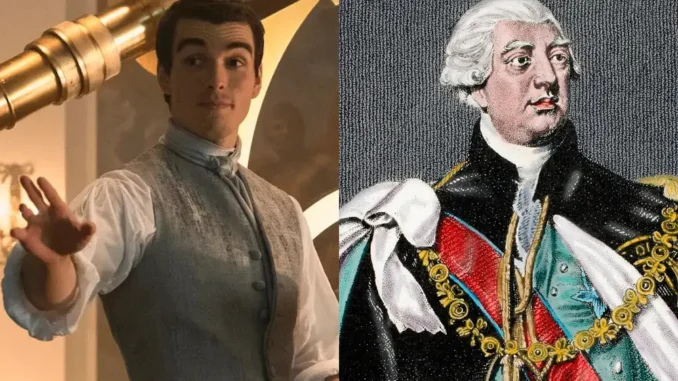
“Queen Charlotte: A Bridgerton Story” depicts the real illness that King George III experienced, though it has been debated by historians.
While the first two seasons of “Bridgerton” hinted that the king (James Fleet) is not entirely well in 1813, “Queen Charlotte” goes further into the past and portrays a full picture of the king (Corey Mylchreest) struggling with a mental disorder and the weight of the crown.
After Charlotte marries the king, he separates himself from her, causing tension in their new relationship.
Episode four of “Queen Charlotte” reveals that the king is suffering from some sort of mental health disorder, causing him to black out and hallucinate.
“Queen Charlotte” is loosely based on history, and it seems the show’s writers are pulling recent discoveries about the real monarch into this plot. Here’s what to know.
While records show that the real King George III was mentally ill, historians debate the cause of the illness.
George has always been described as the “mad king who lost America,” and there are recorded moments in history that indicate the monarch was mentally ill, including the fact that his eldest son, George IV, had to step in to rule as prince regent in the last few years of the king’s life because he became too mentally unfit to rule.
A theory arose in recent years that the king was actually suffering from porphyria, a genetic blood disorder that can cause confusion, hallucinations, and paranoia.
Other historians theorized that the king was suffering from mental illness after analyzing his journals.
The BBC reported in 2013 that one study based at St George’s, University of London, found that the monarch’s letters had similar symptoms to patients experiencing the manic phase of psychiatric illnesses like bipolar disorder.
While “Queen Charlotte” never explains what exactly is wrong with King George, it appears to be following the mental illness theory with the way the series presents the monarch, who only hallucinates when he is nervous and under a significant amount of pressure.
In addition, “Queen Charlotte” — which takes place between two timelines, one in 1761, and the other in 1817 — follows history by portraying the king’s deterioration in later life and introduces Charlotte and George’s son as the prince regent in the scenes set in 1817.
“Queen Charlotte” star Corey Mylchreest says the writers never gave him a proper diagnosis for the king.
Corey Mylchreest, who plays the young King George, told Variety that the writers did not diagnose the character, but he came up with his own explanation while working with director Tom Verica and a specialist.
“As a show, we don’t diagnose him, but as an actor, I simply had to make a decision. Otherwise, the work is going to be nonspecific, and it can be offensive. I did a lot of research and I had an idea of what it was, learning about his childhood and how that can affect stuff,” said Mylchreest. “It’s a gift as an actor because it’s such a challenge but it doesn’t afford you anything other than permission to go 100%.”
He added: “If you don’t commit fully, then you’re going to almost offend the honor of the character — both that Shonda has written, and the real guy that I fell in love with when I did my research. It’s a man who is dealing with the subsequent shame and self-hatred that comes as a result of that affliction.”
Golda Rosheuvel told Insider in 2020 that the writers of “Bridgerton” season one didn’t narrow down a diagnosis either.
When older Queen Charlotte actor Golda Rosheuvel spoke to Insider in 2020, she said that former “Bridgerton” showrunner Chris Van Dusen “never discussed” the specific condition of King George.
The actor told Insider that she and Van Dusen “never discussed” the specifics of her onscreen husband’s condition.
“It was just from Chris’ mind,” she said before pointing out that the show isn’t a biopic, but rather a reimagined version of history. “Back then in the 1800s, they wouldn’t have known what bipolar was. The unknown of that would be terrifying, I think. The outbursts would be terrifying.”
The king’s condition is a mere subplot in “Bridgerton” season one, which revolves around the high-stakes social season of 1813, but Rosheuvel felt like there was a “real importance” to show the royals’ dynamic in order for viewers to better understand the queen.
“In public, it’s very lavish. It’s very fun. It’s very naughty. It’s very regal. There’s a position of power. In private, I think you see her as a real human being who desperately, desperately, desperately loves her husband and is having to deal with the unknown,” Rosheuvel said. “She’s a rounded character.”
Rosheuvel added that the most memorable scene to film in “Bridgerton” season one was between her and Fleet.
In episode five, the couple shares a rare interaction over dinner. Charlotte tells her husband that both she and his subjects “miss” him, and he reacts with confusion, explaining that he’s right in front of her.
When George asks about their daughter, Amelia, Charlotte gently reminds him that she died several years prior. (In real life, Amelia, who was reportedly the king’s favorite child, died after contracting tuberculosis.)
The king then lashes out and throws his dinner plate to the ground, accusing Charlotte of killing Amelia.
“That was the first scene I did with him,” Rosheuvel said, referring to her costar. “Before then, it had been balls and balls and tea parties and tea parties. It was the first time that I could show her intimate side and her private side and I was really excited for that to be seen by people.”
“Queen Charlotte: A Bridgerton Story” is available to stream on Netflix.
Disclosure: Mathias Döpfner, CEO of Business Insider’s parent company, Axel Springer, is a Netflix board member.
